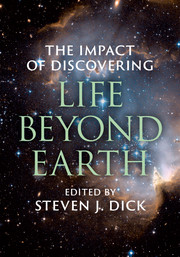Book contents
- Frontmatter
- Dedication
- Contents
- List of contributors
- Introduction: Astrobiology and society
- Part I Motivations and approaches: How do we frame the problems of discovery and impact?
- Part II Transcending anthropocentrism: How do we move beyond our own preconceptions of life, intelligence, and culture?
- Part III Philosophical, theological, and moral impact: How do we comprehend the cultural challenges raised by discovery?
- Part IV Practical considerations: how should society prepare for discovery – and non-discovery?
- 16 Is there anything new about astrobiology and society?
- 17 Preparing for the discovery of extraterrestrial life: are we ready?: Considering potential risks, impacts, and plans
- 18 Searching for extraterrestrial intelligence: preparing for an expected paradigm break
- 19 SETI in non-Western perspective
- 20 The allure of alien life: Public and media framings of extraterrestrial life
- 21 Internalizing null extraterrestrial “signals”: An astrobiological app for a technological society
- Contributor biographies
- Index
- References
16 - Is there anything new about astrobiology and society?
from Part IV - Practical considerations: how should society prepare for discovery – and non-discovery?
Published online by Cambridge University Press: 05 November 2015
- Frontmatter
- Dedication
- Contents
- List of contributors
- Introduction: Astrobiology and society
- Part I Motivations and approaches: How do we frame the problems of discovery and impact?
- Part II Transcending anthropocentrism: How do we move beyond our own preconceptions of life, intelligence, and culture?
- Part III Philosophical, theological, and moral impact: How do we comprehend the cultural challenges raised by discovery?
- Part IV Practical considerations: how should society prepare for discovery – and non-discovery?
- 16 Is there anything new about astrobiology and society?
- 17 Preparing for the discovery of extraterrestrial life: are we ready?: Considering potential risks, impacts, and plans
- 18 Searching for extraterrestrial intelligence: preparing for an expected paradigm break
- 19 SETI in non-Western perspective
- 20 The allure of alien life: Public and media framings of extraterrestrial life
- 21 Internalizing null extraterrestrial “signals”: An astrobiological app for a technological society
- Contributor biographies
- Index
- References
Summary
At the intersections of biology and society, scholars have long explored ethical, legal, policy, economic, and other social issues, while also placing emerging science in the context of history and philosophy of science. One tradition has focused on the impact of scientific developments on society, reflecting on eugenics, recombinant DNA, reproductive technologies, human subjects experimentation, genetically modified foods, and other issues in largely reactive ways. Others are trying to anticipate where the science will be going and to outline issues that society is likely to face. Synthetic biology and technologies such as human reproductive cloning raise additional questions about whether we should forbid some science altogether. Stem-cell research or genetic engineering of food and people raise questions about appropriate regulatory responses. Experiments with pathogens and sequencing genes of dangerous organisms raise questions about control of knowledge. The National Science Foundation's Program on the Science of Science Policy explores issues of how science policy gets made and what factors influence the decisions.
Astrobiology falls into this complex world of biology and society, and here I ask: “Is there anything new under the Sun?” Or, more precisely, “Is there anything new under and beyond the Sun?” Have we already heard all the issues and are now just applying them to astrobiology in particular? Or are there special features of astrobiology that call for new thinking or raise new questions? Providing answers requires thinking about the presumed domain of astrobiology, then its implications, which in turn benefits from a look at the context of issues of biology and society more generally.
The domain of astrobiology
NASA defines astrobiology as “the study of the origin, evolution, distribution, and future of life in the universe.” Further: “This multidisciplinary field encompasses the search for habitable environments in our Solar System and habitable planets outside our Solar System, the search for evidence of prebiotic chemistry and life on Mars and other bodies in our Solar System, laboratory and field research into the origins and early evolution of life on Earth, and studies of the potential for life to adapt to challenges on Earth and in space” (NASA 2014a). The “astro” is only part of the story, which includes the origins and evolution of all life.
- Type
- Chapter
- Information
- The Impact of Discovering Life beyond Earth , pp. 249 - 262Publisher: Cambridge University PressPrint publication year: 2015



